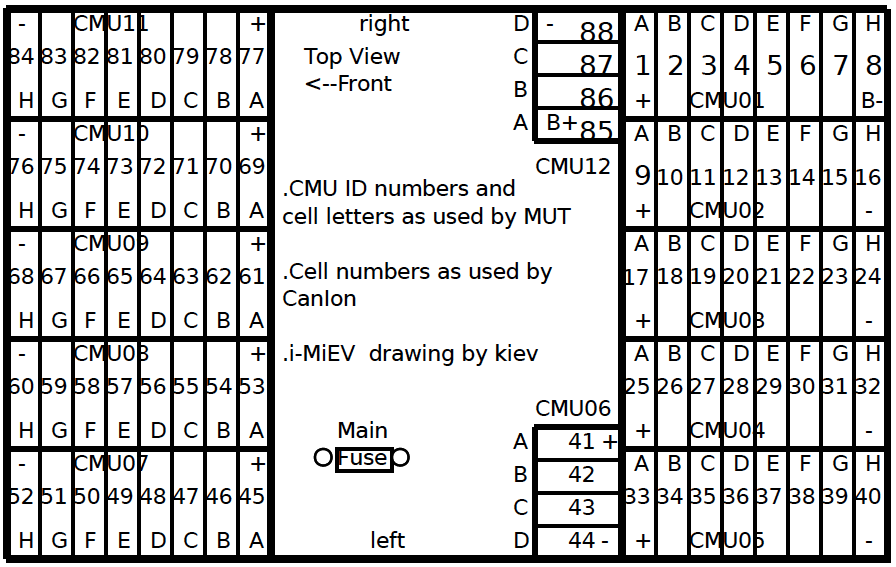1pk
Well-known member
Hi All,
I am looking for some assistance with an issue. Last week I dropped the pack in my 2012 to replace some weak cells. The job went smoothly (i am always nervous that I'm going to screw something up) and the car seemed fine until it shut down during a short test drive ( RBS light and car with exclamation point light came on). After 10 minutes the error lights went out and I drove home.
Using a borrowed Autel MAxipro scanner I sifted through the many DTCs and found P1A71 - CMU08 Battery temperature
I then went for a drive again with Canion open to the battery temperature page and saw that temp sensor 40 was started increasing as soon as I drove up my road. In 200m it had gone from 2C to 30C.
When t40 reached 60C it shut the car down and it wouldn't start for 10 minutes. I am assuming that because the T reading increases and decreases very quickly that the cell itself is not heating up and cooling down.
The odd thing is that when accelerating or regenerative braking, the temperature climbs, when maintaining speed on flat road, the temperature is stable and when stopped the T drops quickly.
So I assumed that I screwed up one of the CMU boards when I was changing cells, but CMU08 is on the block containing cells 53-60 and I didn't even remove that one from the tray.
according to the chart on this thread https://myimiev.com/forum/viewtopic.php?t=2621 T40 corresponds to cell 53.
I removed CMU02, CMU03, CMU09, CMU10, CMU12 when I changed out cells.
I would like to try and fix this in one go. I have to ask a neighbour for his lift and his time when I do this work and I know he enjoys helping but I feel it is a lot to ask of him. So I am hoping for some assistance to drill down to the problem.
Questions.
If I replace the board on CMU08 should that fix the problem?
Could there be another cause of this issue?
I been through a long thread by Martin Winlow on speakev regarding problems with a CMU board, so I now have a little knowledge, but I am not knowledgeable about circuits and electronics.
I would greatly appreciate any assistance with this issue. This is the car I drive daily and without it life is going to be quite challenging.
Cheers and Thank You
Pete
I am looking for some assistance with an issue. Last week I dropped the pack in my 2012 to replace some weak cells. The job went smoothly (i am always nervous that I'm going to screw something up) and the car seemed fine until it shut down during a short test drive ( RBS light and car with exclamation point light came on). After 10 minutes the error lights went out and I drove home.
Using a borrowed Autel MAxipro scanner I sifted through the many DTCs and found P1A71 - CMU08 Battery temperature
I then went for a drive again with Canion open to the battery temperature page and saw that temp sensor 40 was started increasing as soon as I drove up my road. In 200m it had gone from 2C to 30C.
When t40 reached 60C it shut the car down and it wouldn't start for 10 minutes. I am assuming that because the T reading increases and decreases very quickly that the cell itself is not heating up and cooling down.
The odd thing is that when accelerating or regenerative braking, the temperature climbs, when maintaining speed on flat road, the temperature is stable and when stopped the T drops quickly.
So I assumed that I screwed up one of the CMU boards when I was changing cells, but CMU08 is on the block containing cells 53-60 and I didn't even remove that one from the tray.
according to the chart on this thread https://myimiev.com/forum/viewtopic.php?t=2621 T40 corresponds to cell 53.
I removed CMU02, CMU03, CMU09, CMU10, CMU12 when I changed out cells.
I would like to try and fix this in one go. I have to ask a neighbour for his lift and his time when I do this work and I know he enjoys helping but I feel it is a lot to ask of him. So I am hoping for some assistance to drill down to the problem.
Questions.
If I replace the board on CMU08 should that fix the problem?
Could there be another cause of this issue?
I been through a long thread by Martin Winlow on speakev regarding problems with a CMU board, so I now have a little knowledge, but I am not knowledgeable about circuits and electronics.
I would greatly appreciate any assistance with this issue. This is the car I drive daily and without it life is going to be quite challenging.
Cheers and Thank You
Pete


































